How many weed plants can you grow per square metre?
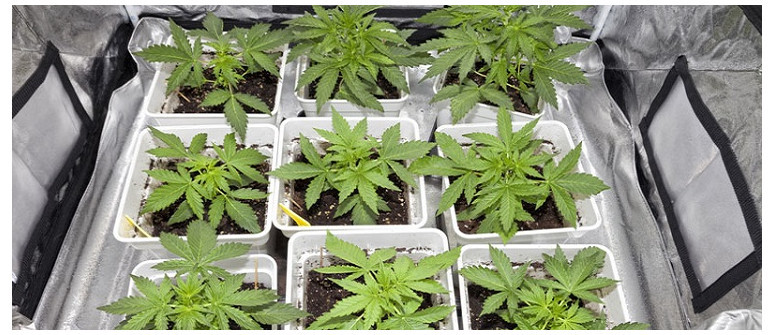
In this article, we look at the different factors that affect how many cannabis plants you can fit in each square metre of your grow space. By the end of this text, you'll have a much better idea of how to achieve optimal yields indoors, regardless of the size of your grow space.
Contents:
When it comes to growing weed, most of us would like to harvest as much as possible. And with the right approach, achieving a large yield is a feasible goal. If growing indoors, this is done by optimising the amount of plants per square metre of growing space.
In this article, we look at the different factors that affect how many plants you can fit into a cultivation space, and which methods render the best results.
How many cannabis plants can you grow per 1m²: quick answer
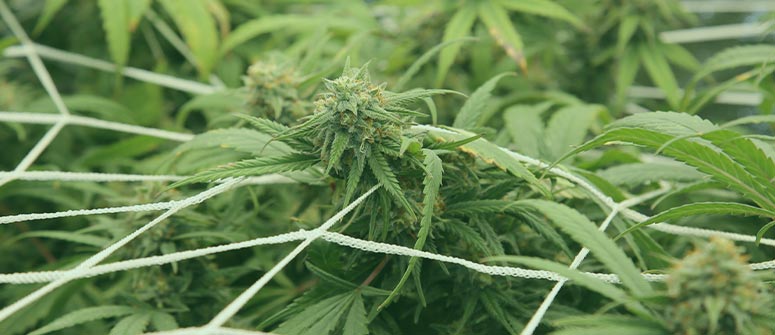
Put very simply, you can grow between one and eight plants per square metre. But this is quite a big range. The relevant factors include:
- Pot size: Bigger pots mean bigger plants.
- Genetics: If you’re growing mighty sativas, you won’t fit as many in.
- Autoflowering or photoperiod: Autos tend to be smaller, but photoperiod plants can be switched to flowering early to keep them small.
- Training methods (or lack thereof): Certain training methods allow you to grow more plants in a smaller space and get more out of the crop as a whole.
Now that you’re acquainted with the main factors affecting how many cannabis plants you can fit per square metre, keep reading to expand your knowledge of how to harness each factor to produce the largest, highest-quality harvest possible.
Which factors determine how many weed plants you can grow?
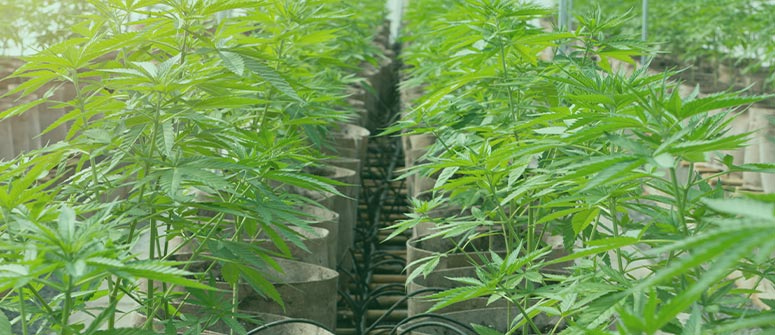
Indoor grow spaces tend to be measured in terms of metres squared. Lights and grow tents are often produced to fit these dimensions, and will be described in such terms.
This is because, when growing indoors, growers tend to look at the whole grow-op as a single entity—at least in terms of the final yield. Usually, when growing inside, each plant won’t yield its absolute maximum; instead, it's about maximising the amount of space in the grow room.
For instance, one large plant grown in a space with dimensions of 1m² will yield less bud than three smaller plants grown in the small space. Gram for gram, smaller plants produce more bud. So numerous smaller plants is better than one big one. Note that, outdoors, growers tend to treat each plant as a single entity, and thus yield is measured per plant.
Now, let’s expand upon the factors impacting how many plants we can comfortably fit in a grow space.
Genetics
First and foremost, genetics is perhaps the biggest factor.
Pure sativa landrace strains, for instance, tend to grow very tall and spindly, and require a lot of space. Indicas, on the other hand, usually remain fairly compact and bushy. Moreover, some sativas have very long flowering periods (anywhere from 10–16+ weeks) compared to some fast indicas (which tend to flower for 7–11 weeks). So if you take this example, you’ll see that you won’t be able to fit as many sativa landraces into a grow space compared to indicas.
Whichever strain you go for, you’re best off picking plants with a similar final height. A canopy with an even height is very important when it comes to growing cannabis successfully indoors. If you have one or more taller plants in your grow, then you’ll have to move the lights to accommodate them, meaning the smaller plants will get less light than they need, which will negatively affect their growth.
Autoflower or photoperiod
Crucially, your choice of autoflowering cannabis seeds or photoperiod cannabis seeds makes a difference in how many weed plants you can fit into a grow space.
Auto seeds have the benefit of growing into smaller plants. This means that a simple training method such as sea of green (SOG) is easy with them, as they naturally stay low and compact. The downside is that you cannot choose to switch them to flowering when it suits you, meaning they are destined to be more or less one size.
What’s more, high-stress training techniques can be very damaging to autos if not executed properly, meaning training should generally be avoided unless you really know what you’re doing. With all that said, autos are very well-suited to growing in a small space.
On the other hand, though photoperiod plants tend to grow taller, they can be switched from the vegetative stage to the flowering stage whenever the grower chooses. Also, photos are much more resilient in the face of high-stress training techniques than autos.
Duration of growth
Something else to consider, and something that’s closely linked to genetics, is a strain’s flowering period.
Though there are ways around it, it’s usually best to fill a space with plants that have similar flowering periods, as this makes it much easier. First off, you can switch your plants from the vegetative stage to the flowering stage at the same time (or they’ll do it on their own if growing autos). At this point, you want them all to be roughly the same size, otherwise you’ll encounter the lighting problems listed above.
Once plants are flowering, it helps if they develop at pretty much the same rate. It can be frustrating to have to harvest individual plants at different periods. More importantly, if you pull some plants out too early, then you’re just wasting space and energy.
Say you’re growing eight plants: six indicas and two sativas. After nine weeks of flowering, your indicas will probably be ready for harvest. But your sativas might need another month before they’re ready. They won’t grow any bigger during this time, and so you’ll have two plants using up an entire grow space.
Grow space dimensions
Obviously, the dimensions of your grow space play a huge role in how many plants you can reasonably grow.
Small tents begin at around 50 × 50cm, and larger ones can be quite huge by a home grower’s standards. The smallest tents are only suitable for particularly small, untrained plants, or a small amount of trained plants. Remember that tents also have to fit lighting and ventilation systems too.
So, how many plants can you fit in a 1m² tent? As mentioned, a 1m² tent can realistically accommodate one untrained plant or up to eight trained plants. Then, you can just count up from here. A 2m² plant will fit double this amount, and so on.
Without knowing about other factors, the size of your growing space alone won’t tell you how many plants you can grow, unless you plan to do absolutely no training—in which case you can aim for around one plant per square metre.
Temperature and humidity
Fluctuations in temperature and humidity will likely reduce the overall yield per square metre, as they can simultaneously increase a plant’s size while reducing the amount of bud it produces.
Essentially, large changes in temperature and humidity can cause plants to draw more water in, which will make them grow bigger and take up more space. But this increase in size won’t make its way to the bud sites, which will instead become light and fluffy, rather than dense and compact.
What’s more, major changes between day and night temperatures can cause plants to stretch, without increasing bud development. In fact, the only reason that a grower might make the nights significantly cooler is to maximise colouration in plants that are prone to displaying purple or blue hues.
When it comes to fitting as many plants as possible into a cultivation space, though, maintaining the ideal humidity and temperature levels is key.
Pot size and type
Bigger pots mean bigger plants, but they also take up more floor space compared to smaller ones. Note that you can fit more square pots into a space than round ones, as they fit together without wasting space.
For most strains of cannabis, they’ll need at least an 11-litre pot once they are fully developed. But how many 11-litre pots can fit in one square metre? The good news is it’s quite a lot: nine, to be exact!
However, this doesn’t necessarily mean you have the space for nine full-grown plants. Without serious training, plants will often grow wider than their pots, meaning you might struggle to fit all the plants into your space, much less give them adequate room to breathe and develop.
But the point is, you can fit a good amount of pots into a small space. These days, many growers use fabric pots or air-pots instead of regular pots. These provide better aeration and drainage, and also fit together more comfortably than traditional ceramic of plastic plant pots.
Grow lights
The type of grow lights you use will affect how many cannabis plants can grow per square metre as well. Different light setups give out a different intensity of light, which essentially determines how many plants they can satisfy.
What’s more, light doesn’t spread evenly. The space directly beneath a grow light will be much brighter than the edges. This means that it can be worth growing fewer plants under good light, rather than growing more plants but depriving some of adequate illumination. Plants grown on the periphery will almost definitely end up developing small buds.
Below, we’ll outline HID, CFL, and LED lights, as the cannabis world still can’t agree on the best lights for growing cannabis.
HID
For many years, high-intensity discharge (HID) lights were the go-to for cannabis growers. Think big, hot lights encased in metal reflectors—these are HID lights. Although, these days people are moving over to LEDs. More on this shortly.
You can do some simple maths to figure out how many plants you can optimally fit beneath you HID grow lights. Take the wattage of your light and divide it by 75, then round this up to the nearest whole. This figure will tell you how many plants the light intensity of your HIDs can satisfy.
For example:
- 150W/75 = 2 plants
- 250W/75 = 4 plants
- 400W/75 = 6 plants
- 600W/75 = 8 plants
- 1000W/75 = 14 plants
CFL
Compact fluorescent lights (CFL) are often used for cannabis seedlings and young plants, as they give out a lot of blue light, which helps with root growth and development. Some growers, however, will use them throughout the entire cannabis grow (this is not recommended for those looking to optimise yield).
Similar rules apply as with HID lights, except you divide the wattage by 150.
Some examples:
- 150W/150 = 1 plant
- 250W/150 = 2 plants
- 400W/150 = 3 plants
- 600W/150 = 4 plants
- 1000W/150 = 7 plants
As you can see, CFLs are half as efficient per metre squared compared to HIDs, which is worth considering when it comes to choosing grow lights.
LED
Finally, LED lights. LEDs are popular as they use much less energy compared to HIDs, but can give out just as much, if not more, light intensity. Plus, they don’t produce much heat.
LED lights can also usually be switched from a “veg” to a “bloom” setting. This causes them to give out more light from either the blue end or red end of the spectrum, meaning they can be optimised for the stage of growth your plants are in.
Regarding how it affects the number of plants you can fit in a space, you can’t beat a high-quality LED setup. Though be aware, there are many poor-quality lights out there masquerading as good ones.
At their most powerful, a good LED light is almost twice as powerful as an HPS light—meaning you can grow almost twice the number of plants beneath them, and use less energy!
As LEDs vary more than other grow lights, it’s difficult to give an exact recommendation regarding how many plants per m². However, quality manufacturers should advertise how many plants can be cultivated beneath their grow lights, so do some research!
Light strength
Weak lights, or lights that are too far from your plants, will cause them to stretch and grow taller than they need to. Ultimately, this will reduce the amount of plants you can comfortably fit in your space.
Therefore, you must always ensure that your lights are both strong enough and close enough to your plants to stop them from stretching. Be careful though, as you don’t want to burn them!
Plant training
Plant training is one of the most important factors when it comes to determining how many plants you can grow per square metre. Certain methods help to squeeze more plants into a small space, while other methods help individual plants to be more productive.
LST
Low-stress training is the easiest and least stressful training technique. As such, it works well for autoflowers too. Essentially, it just involves tying the main stem down so that the plant grows horizontally. This increases the surface area exposed to direct light and helps it to be more productive. Often, it’s combined with SOG or ScrOG.
If using LST in isolation, expect to fit between two and four large plants per metre squared, or maybe four to six smaller plants.
Screen of green (ScrOG)
ScrOG involves growing plants through a mesh screen and then tying this growth down to create a broad, flat canopy that receives an equal distribution of light, and a lot of it. Growers may also use topping (more on this below) alongside ScrOG.
ScrOG is perhaps the most effective way to maximise yield in your indoor grow. Expect to fit between two and four scrogged plants into each square metre of growing space.
Sea of green (SOG)
SOG is much simpler, and simply involves growing many small plants side by side. Generally, there is no manipulation of the plants themselves. With photoperiod plants, growers just switch them to flowering much sooner than usual to keep them very small. Autos, of course, make the switch of their own accord, generally after just 3–4 weeks.
You can fit a lot of plants into one square metre when using SOG—up to 16, in fact. Expect to fit anywhere between 4–16 plants per m² with this method.
Fimming and topping
Fimming and topping are high-stress training techniques that involve damaging or removing the main growing tip of the plant. With fimming, you cut off about half of the growing tip itself, whereas with topping, you completely remove all growth just above the topmost node.
When this part of the plant is damaged or removed, it responds by producing 2–4 new growing tips, which will eventually develop into main colas (where the most bud grows), potentially increasing overall yield. It also causes plants to grow outward and become bushier, rather than growing tall.
Whether used alone or with other plant training techniques, topping and fimming are some of the most effective training methods for increasing yield.
If you’re keeping your plants on the larger side, you’ll only be able to fit one or two specimens per metre squared. If you’re keeping them small and combining these methods with another method, such as ScrOG, then expect to fit up to 10 plants into one metre squared.
Lollipopping and main-lining
Lollipopping involves the radical removal of unnecessary growth during the late vegetative phase, just before flowering. It’s like extreme pruning. Lower branches and smaller bud sites are removed, leaving behind big bud sites and enough leaves to keep photosynthesis going.
This helps to redirect energy to the development of the larger bud sites, increasing their growth. Lollipopping can be practised on its own or alongside other training techniques. Alone, it shouldn’t affect how many plants you can fit per metre squared.
Main-lining is a highly complex training technique, taking elements from topping, LST, and ScrOG. It involves topping the plant above the third node and removing all other growth. Then, it grows back from this point. The process can be repeated several more times during veg. The plant is then tied down or woven through a mesh screen to finish growing.
All working together, these methods drastically manipulate the way a cannabis plant grows and develops buds. A main-lined plant can grow very bushy. Expect to fit anywhere between one large plant and four small plants into a single square metre.
How much weed can you harvest per plant?
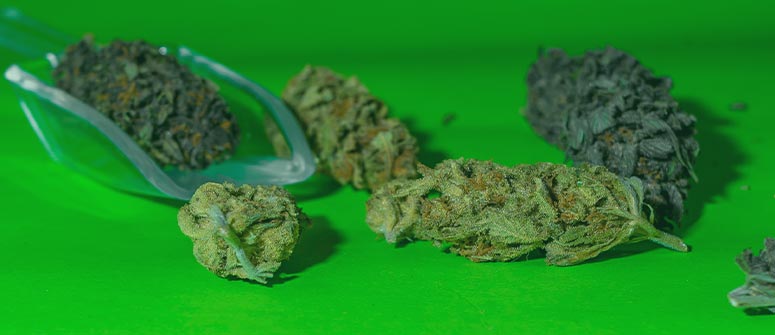
When you buy cannabis seeds, you’ll notice that breeders advertise pretty large numbers regarding a plant’s potential yield. Often, these numbers are provided per square metre for indoor growers.
If the number seems very high, then it probably doesn’t represent one cannabis plant grown lazily beneath a grow light, but rather many trained plants grown in the optimal conditions. So if you’re wondering how to actually achieve these numbers, that’s how.
There are too many factors at play to say how much weed your grow will produce. For one thing, it varies depending on your plants' genetics, and on how you choose to grow them. But a good grow should produce at least a few hundred grams of dried weed per metre squared, and can produce much more.
How much weed can you grow legally?
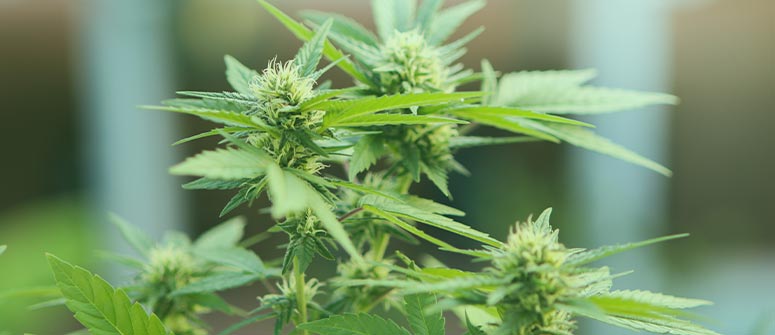
Depending on where you live, you might even be able to grow weed legally! Although, it’s always worth performing thorough research before embarking on a grow, as there are often caveats and subtleties to laws even where it is legal/decriminalised.
Here a few examples of permitted (or not) amounts:
- Netherlands: Despite its fame as a cannabis capital, it’s actually illegal to grow any amount of cannabis in the Netherlands. In most cases, those who grow up to five plants will not be prosecuted. However, you still could be, so be careful!
- Portugal: Even though all drugs were decriminalised in Portugal in 2001, it’s also still illegal to grow cannabis there. What’s more, it’s even illegal to sell equipment associated with growing cannabis.
- Spain: Adults can grow up to two cannabis plants at a time in Spain, so long as they are for personal use and are out of sight. In Catalonia (of which Barcelona is the capital), laws are more relaxed, and cannabis clubs exist in a legal grey area.
- Germany: Though not yet passed, Germany is set to become the second European country (after Malta) to properly legalize recreational cannabis. Details on home cultivation are not yet finalised.
- Malta: In Malta, cannabis is legal, and you can grow up to four plants at home.
- USA: Laws vary from state to state in the US, and are subject to change. Check the laws in your home state before growing marijuana.
The laws surrounding cannabis are changing at long last, and look as though they will continue to become more relaxed in many nations as time goes on. Keep abreast of new developments regarding your country!
Grow as much cannabis as possible indoors
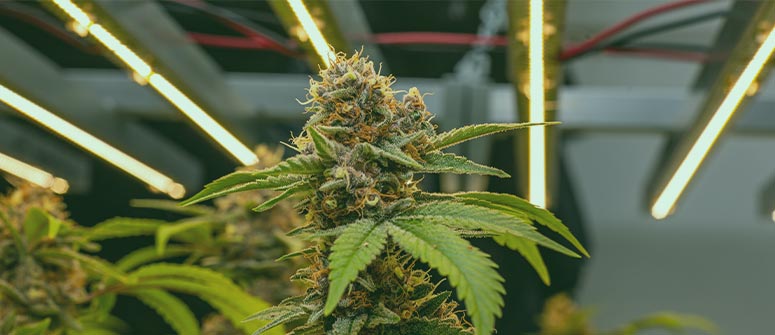
As you can see, it’s possible to fit a lot of marijuana plants into a small space. If you really want to get as much as you can out of a space, then your best bet is to grow indica or indica hybrid plants and to use training techniques.
If you’re new to growing, focus on honing your skills and learning to love the process before obsessing over getting as many grams as you possibly can. Quality over quantity, as they say!




